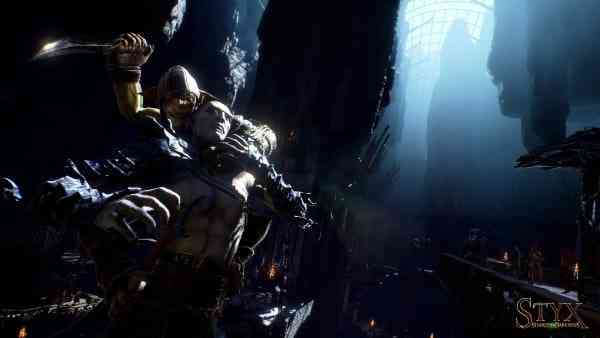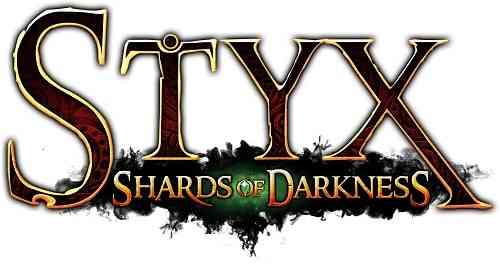Styx: Shards of Darkness Review
There were several moments during my playthrough of Styx: Shards of Darkness that felt as if the game was going out of its way to frustrate me. At its core, Styx wants to be a pure stealth game akin to the old Thief series, with every level designed around sneaking from room to room, building to building, stealing gold, forging documents, and opening vaults without ever being seen or heard. You play as the titular Styx, a talking goblin thief with an addiction to magic-imbuing “amber” who has zero combat abilities, his talents instead focused on evasion, espionage, and burglary. To slink through environments he can craft tools like poison bolts, booby-trap alarm bells, throw sand to douse nearby torches, and employ the use of Amber, the game’s version of mana, to do things like turn invisible or vomit out shoddy controllable clones of himself.
With all of those seemingly clever mechanics at your fingertips, I had high hopes for the game’s potential. Unfortunately, that potential never really comes into the light, overshadowed by just how unpolished it all is, a fact that becomes evident very quickly. After a short cinematic introduces you to the game’s low-fantasy setting, titular protagonist, a few of the thieving tools at his disposal and the overall tone of the “comedy” developer Cyanide is going for, you are thrust into a game that shows off its best and worst features very early on.
As I said, there are some really clever ideas in this game. The game avoids a cluttered HUD, for instance, by using lights on Styx’s dagger to convey how hidden you are. The bodies of slain enemies can be dissolved using craftable acid solutions. Your vomit-clones can be upgraded through the skill tree to lay booby-traps and be spawned at specific locations, and your “amber vision” can be upgraded to track the scent of enemies and observe their movement patterns.
______________________________
“Styx: Shards of Darkness never progresses beyond being a moderately functional game with low-fantasy aspirations.”
It’s also a visually stunning game, making full use of the Unreal 4 engine to make beautifully sculpted, stiffly animated character models, high-res textures and detailed environments that are aesthetically quite distinct from each other. The sound design is also on point, employing audible cues to indicate your proximity to enemies and warn you about potential dangers.
The issue with Styx’s design is that the game never seems to take its own mechanics very seriously. None of them work the way you would expect, and that often leads to deaths or fail states that feel entirely out of your control. This is even true of how it executes the most basic stealth game scenarios; if you’re hanging from a ledge or hiding behind a corner, for example, you can whistle to attract a nearby enemy, but they almost invariably keep themselves an inch or two out of position, placing you just within their line of sight while preventing you from enacting the stealth kill that a well-polished genre title would allow for. You’re encouraged to put out torches and hide in the shadows, but often those torches are in rooms that are otherwise littered with candles and lamps, making it seem rather silly that turning off one torch suddenly makes you totally imperceptible.

Even the game’s basic platforming doesn’t work consistently. I constantly found myself falling off of ledges I was using to dump bodies off of, jumping towards vertical handholds that Styx would just outright miss, and don’t even get me started on the utterly dysfunctional rope-swinging mechanic.
Of course, that’s not to say the game never works right – after the first two relatively claustrophobic levels the game’s level design opens up a bit, allowing for brief moments where you’re able to use its clever ideas in ways that make you feel really empowered. It’s just that those moments are few and far between the more frequent instances of hair-pulling aggravation.

That aggravation is amplified by the game’s overall tone. That “comedy” I mentioned before boils down to Styx being as crass, sarcastic, and boorish as possible while maintaining an attitude like he`s the funniest guy in the room. When he’s not calling the main female antagonist a “bitch” every five minutes, he’s breaking the fourth wall during death cinematics, using thinly-veiled dick jokes to mock you for your ineptitude. The latter was kind of cute at first, but became obnoxious as hell after about the third time I died because of the game’s unpolished mechanics.
Styx: Shards of Darkness had the potential to be a really fun and clever stealth game in a high-fantasy setting with a memorable and witty protagonist. Unfortunately, it never progresses beyond being a moderately functional game with low-fantasy aspirations and an irredeemable main character that would be pretty forgettable if he wasn’t so damn annoying. While Cyanide may hope to get a third Styx game out of this, I think this is one series that should remain in the shadows.
*** PS4 code provided by the publisher ***
The Good
- Clever visual cues for a clean UI
- Crafting/Skill systems allow for a lot of variety
- Visually stunning
The Bad
- Feels unpolished overall
- Unengaging low-fantasy story
- Levels are aesthetically distinct but structurally identical
- 4th-wall-breaking tone ends up feeling smug very quickly

